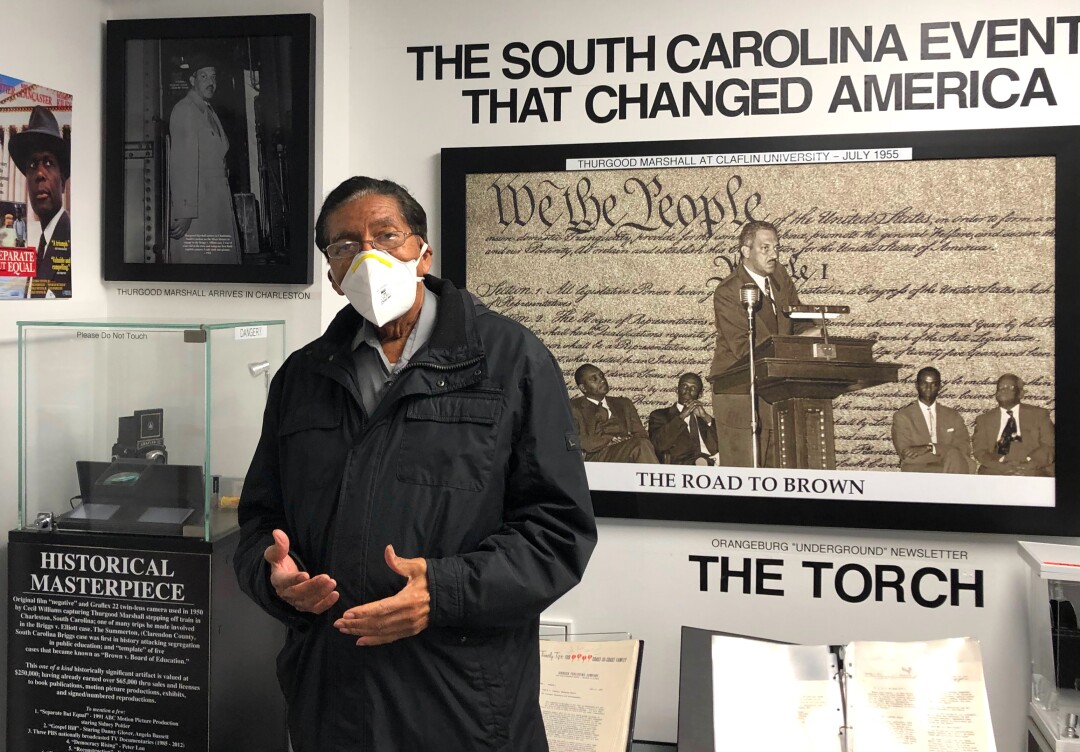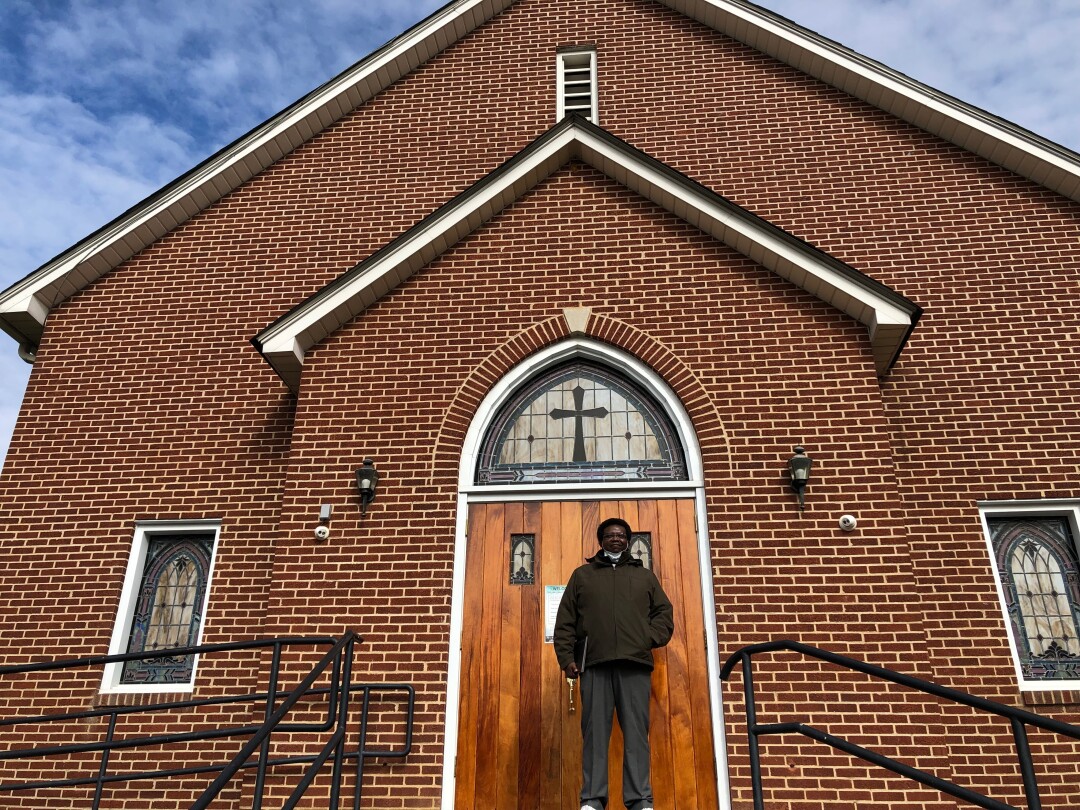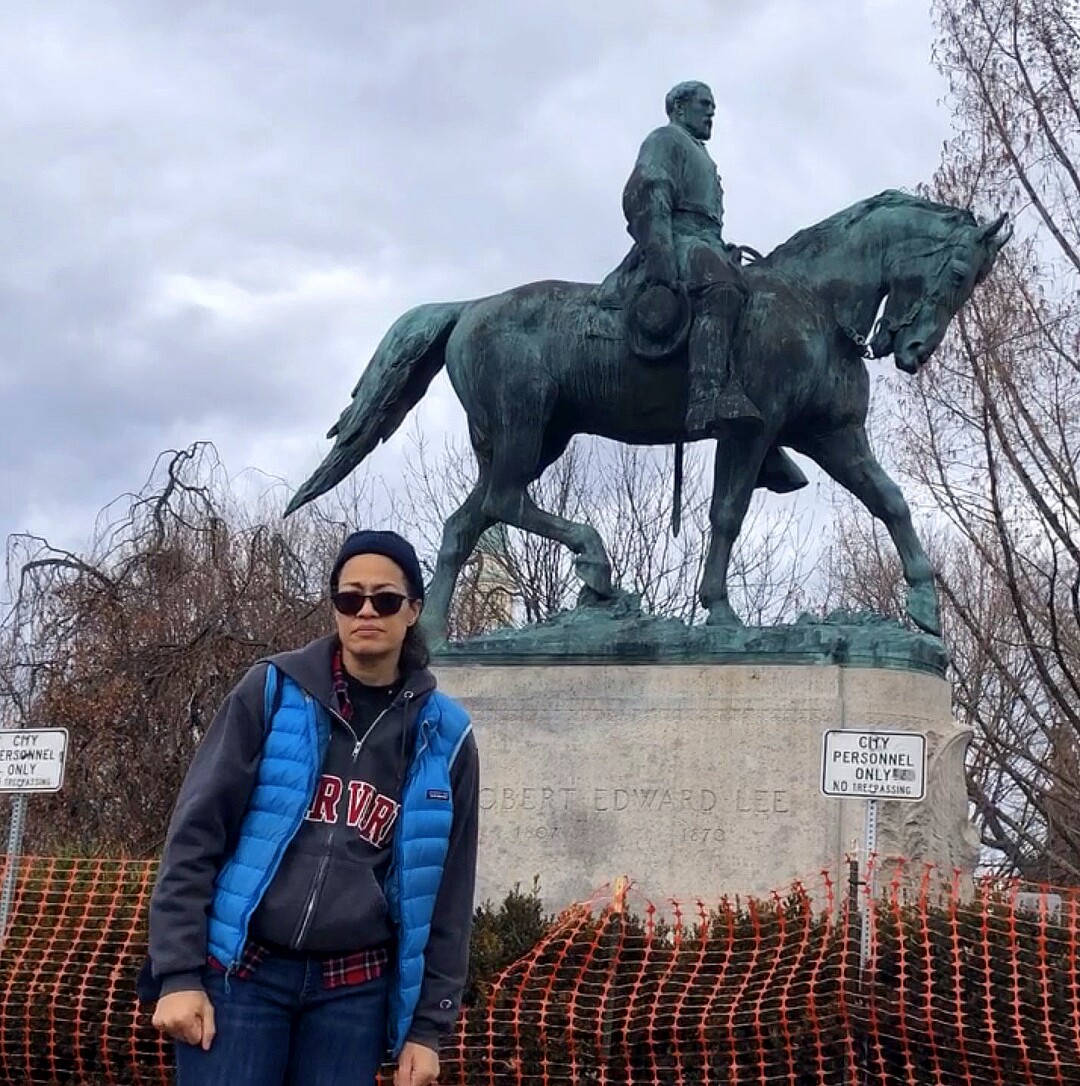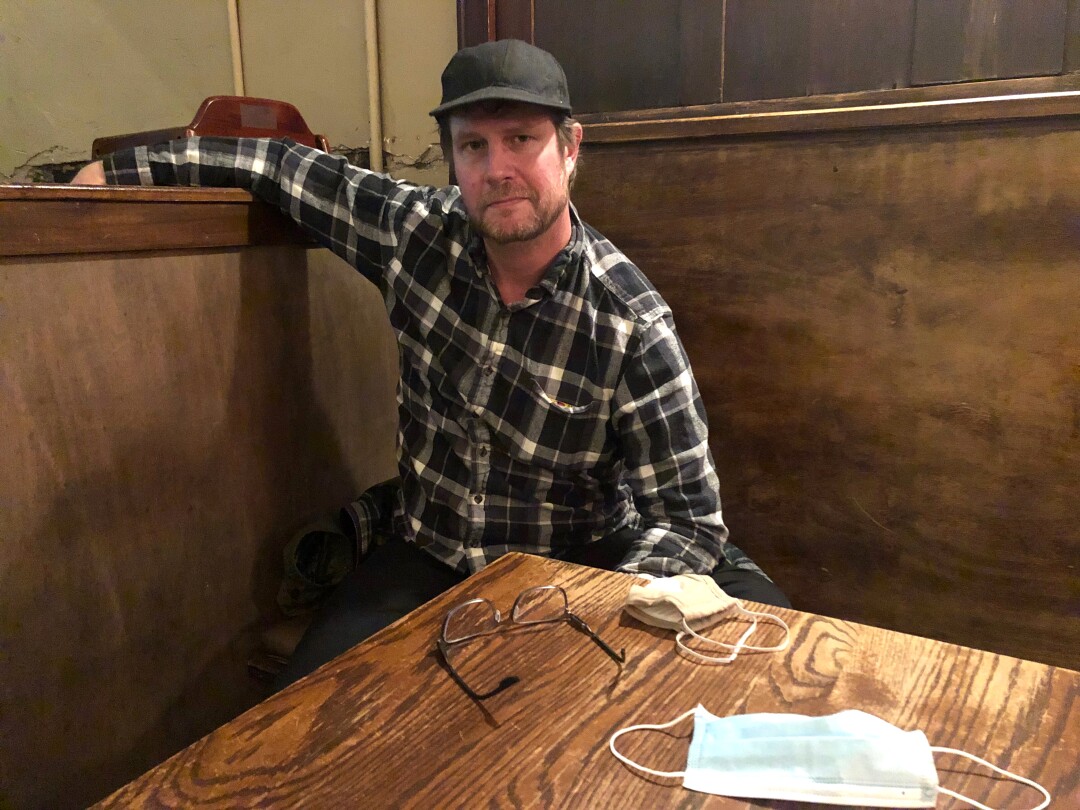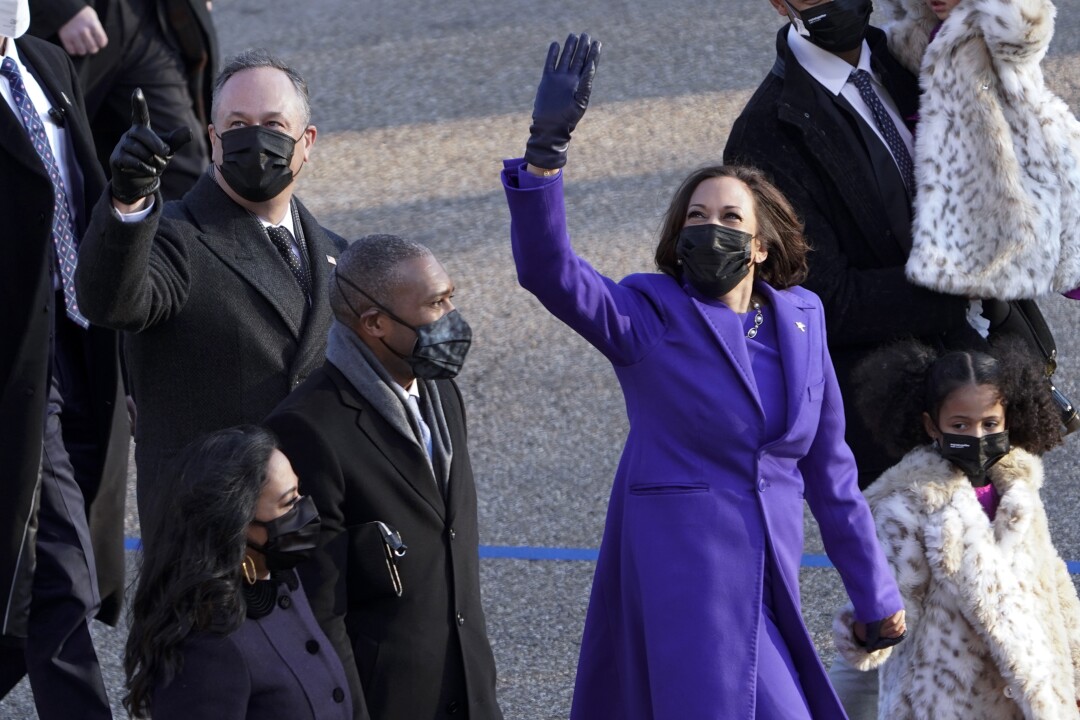[ad_1]
By the time I watched Kamala Harris walk past the White House as the first woman and first woman of color elected vice president, I’d driven more than 600 miles from Charleston to Washington in search of what President Biden calls America’s “soul.”
Time and time again, I was forced to face the war raging in my own.
There’s a side of me that wants to believe this country will someday bestow on my fellow Black Americans the respect we yearn for. But there’s another side of me that sucks its teeth and rolls its eyes at the notion that Black people will ever receive their due in a country where armed white men who call themselves patriots can freely ransack the U.S. Capitol while some of them wave, without irony, Confederate battle flags.
America, it seems, is as conflicted and as divided as I am.
There’s no better place for me to reflect on my inner conflict — or to face the chasm between the fairness our nation guarantees and the injustice it routinely delivers — than in the South, the region where I was born and raised.
The highway leading from North Carolina into Virginia on the way to Charlottesville.
(Tyrone Beason / Los Angeles Times)
MY COUNTRY
As a Black man in America, I’ve always struggled to embrace a country that promotes the ideals of justice and equality but never fully owns up to its dark history of bigotry, inequality and injustice.
Now, more than any time in recent history, the nation seems divided over this enduring contradiction as we confront the distance between aspiration and reality. Join me as I explore the things that bind us, make sense of the things that tear us apart and search for signs of healing. This is the first in a series we’re calling “My Country.”
My journey begins in the moss-draped city of Charleston, S.C., the heart of the old Confederacy where the first shots of the Civil War rang out and where Black Americans like state Rep. JA Moore carry the weight of the country’s racism on their shoulders.
Moore’s sister Myra Thompson was one of nine Black worshipers killed by a white supremacist at Mother Emanuel AME Church in 2015. He ran for office for the first time in 2018 in part to channel his grief over her death into public service.
When I visit his home 20 minutes outside Charleston to talk about his hopes and fears for America, Moore’s 17-month-old daughter, Mariah, runs out to her father, and he sweeps the little girl up in his arms. Something changed in him when Mariah was born.
Moore gave her the name of his great-grandmother Mariah Jackson, whom older family members described to him as unfailingly optimistic about life despite being the granddaughter of slaves.
South Carolina state Rep. JA Moore holds his 17-month-old daughter, Mariah, in their home outside Charleston.
(Tyrone Beason / Los Angeles Times)
“It’s really disgusting that some question Black people’s patriotism. We have peacefully gathered, we have died for this country and yet we still don’t have the freedoms that they take for granted.”
Rep. JA Moore
As Black people, we inherit so much anguish from past generations that sometimes it’s hard to bring the future into focus.
Despite the trauma his family has endured, Moore wants to pass down that same boundless sense of possibility that his daughter’s namesake possessed.
Moore, 35, has no illusions about the severity of America’s problems. He believes that the nation has barely begun to reckon with racism, or the double standard of a country that just weeks earlier on Jan. 6 failed to prevent a white mob from storming the U.S. Capitol while treating Black people as anti-American for protesting police brutality.
“It’s really disgusting that some question Black people’s patriotism,” Moore says. “We have peacefully gathered, we have died for this country, and yet we still don’t have the freedoms that they take for granted. In my opinion, we are the most patriotic.
“Every day, we have to earn our citizenship.”
::
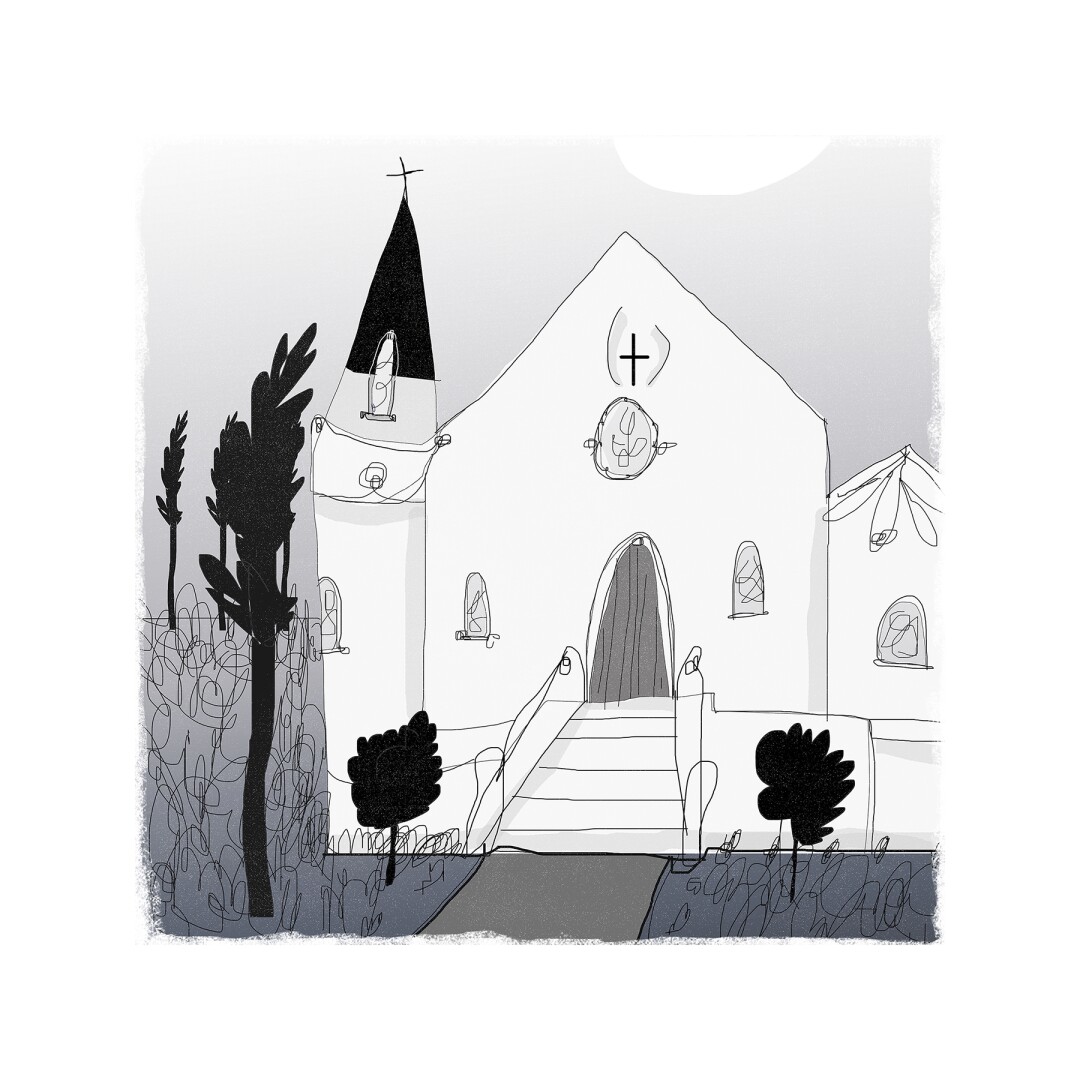
(Hannah Buckman / For The Times)
I start my drive north from Mother Emanuel AME, where President Obama sang “Amazing Grace” at a memorial for the shooting victims and where Biden has said he’s found solace for his own grief. Standing next to the church, its dark gray cross piercing a crisp blue sky, I remember what Moore said about Black people always having to prove our worth in this country.
The massacre in 2015 wasn’t the first tragedy to strike this predominantly Black congregation. One of the founders of the original sanctuary that stood here was executed along with more than 30 others for plotting a slave revolt in the early 1800s. A white mob burned down the church in retaliation, forcing members to worship in secret until it was safe to rebuild.
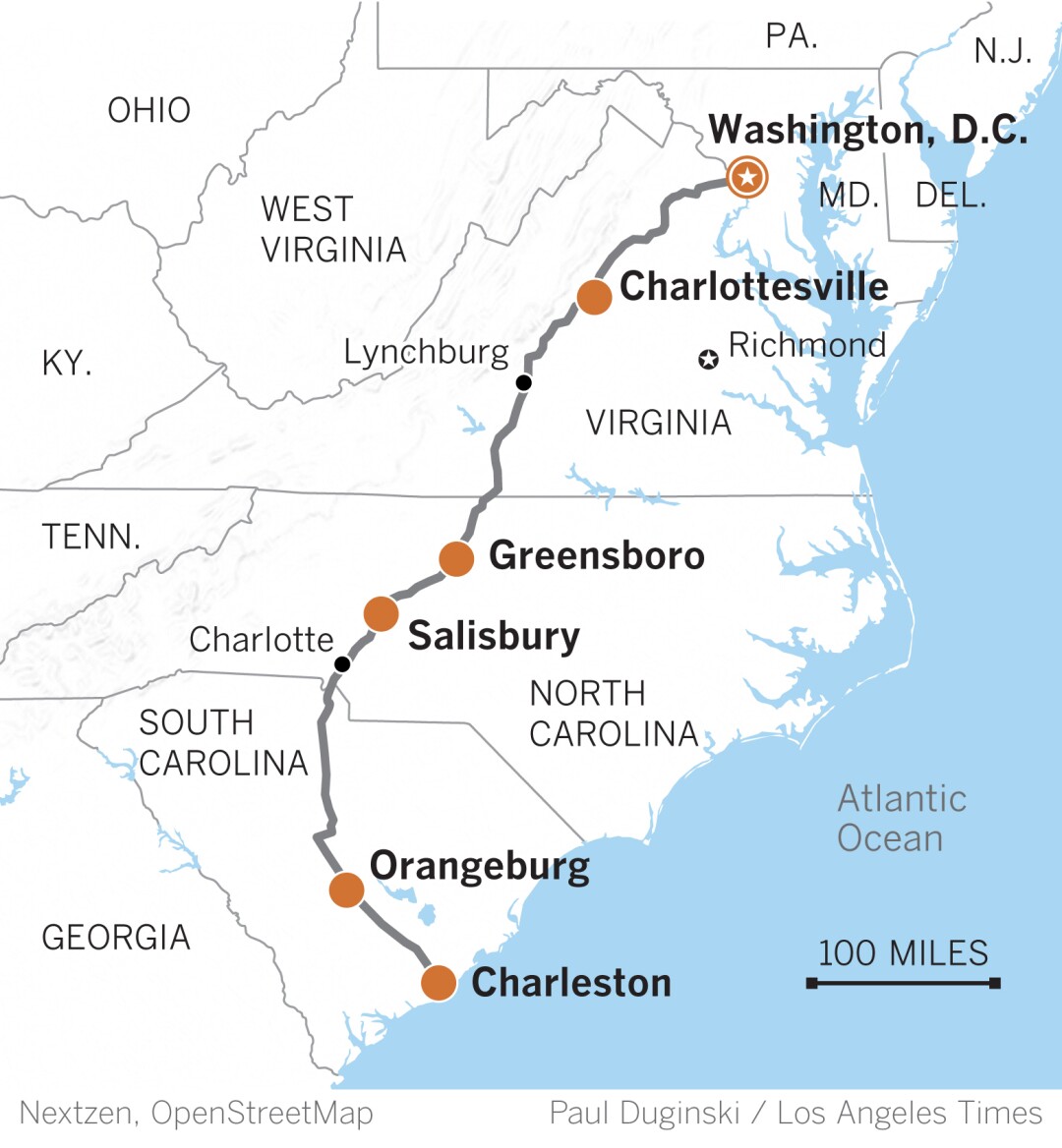
Los Angeles Times reporter Tyrone Beason’s road trip to the inauguration.
(Paul Duginski / Los Angeles Times)
My journey would be full of destinations like this, beautiful landmarks filled with gut-wrenching stories.
About 85 miles north in Orangeburg, Cecil Williams is waiting at his Civil Rights Museum, the only one of its kind in the state.
Williams, 83, is slender with slicked-back hair and wire-framed glasses. He’s devoted the latter part of his life to teaching people about South Carolina’s importance to the Black freedom struggle. An architect as well as a photographer, he designed the futuristic, minimalist building himself in the 1980s.
Inside his creation, which he finally raised enough money to open two years ago, the walls come alive with memories, captured in hundreds of black-and-white photos he took of the civil rights movement in the 1950s and ’60s.
He moves briskly and his eyes glisten as he leads me through each room of his little museum.
Cecil Williams’ namesake museum in Orangeburg, S.C., is filled with pictures he took during the civil rights struggle of the 1950s and 1960s.
(Tyrone Beason / Los Angeles Times)
Williams took many of the photos while freelancing as a teenager and college student for Jet, the Black lifestyle magazine that was part of the Black-owned publishing house that created Ebony.
There’s the photo of the man who would become the nation’s first Black Supreme Court justice, Thurgood Marshall; Williams took that when he was just 13 and Marshall was a civil rights lawyer visiting the state to work on one of the school desegregation cases that would be included in the 1954 Brown vs. Board of Education decision.
A wall is dedicated to the killing of three Black student protesters on the campus of South Carolina State University by state patrol officers in 1968.
Photos of the Rev. Martin Luther King Jr. hang near a cover of Jet that features a portrait of his wife, Coretta Scott King, speaking to striking hospital workers in Charleston the year after her husband’s assassination.
Cecil Williams with a photo of himself drinking from a whites-only water fountain near Myrtle Beach, S.C. “I was thirsty,” Williams said of his defiant sip.
(Tyrone Beason / Los Angeles Times)
“We have entered a new era when domestic violence is going to be a little bit tougher to tame.
Cecil Williams
The most audacious photo in the museum shows Williams staring directly into the camera while drinking, illegally, from a whites-only water fountain.
“I was thirsty,” Williams says, then slips into the next room.
Confederate flags and photos of white supremacist gatherings hang in a separate room that’s as small and suffocating as a closet. Williams built the exhibit to teach visitors the humiliation and terror that his fellow Black Americans have lived with in a state where many white people celebrate the Confederate emblem as a glorious expression of their “heritage.”
His disdain for this whitewashed view of the Old South is evident in the name he’s given this exhibit: “Gone with the Wind.”
Sit-ins and court cases, marches and massacres. My mind drifts from outrage to pride and back again. Williams’ photos and artifacts make plain to me the true price he and other Black Southerners paid for the freedoms that I enjoy today but also, they make clear the debt owed by a white population whose lust for domination made my people’s struggle necessary.
Williams sees parallels between the white nationalism that fueled the siege at the Capitol and the racism he documented in an earlier time.
“We have entered a new era,” he says, “when domestic violence is going to be a little bit tougher to tame.
“I thought this was all behind us.”
::

(Hannah Buckman / For The Times)
The next day is a Sunday. This drive will take me past dozens of churches and “Thank you, Jesus” yard signs and deep into Republican strongholds. On a back road near the town of Salisbury, N.C., a homeowner has hung a Trump 2020 banner on one side of the front door, and on the other side a banner showing Trump standing on a tank against a backdrop of flames.
About a mile away, the Rev. Aldana Allen, a Black man wearing glasses and an Afro he’s let grow out during the pandemic, stands on the porch of Providence United Methodist Church and delivers a socially distanced sermon about “truth and justice.”
I sit alone under a tree on the church’s lawn, with Allen preaching about 20 feet in front of me and two dozen members of his mostly white, conservative-leaning congregation listening from their cars.
The Rev. Aldana Allen of Providence United Methodist Church near Salisbury, N.C.
(Tyrone Beason / Los Angeles Times)
“The Lord is easy to understand, but his children can be so hard,” Allen tells his flock.
He says that Americans have forgotten how to care for one another.
As the Black pastor of a nearly all-white church, Allen, 48, has made it his priority to encourage open discussion on racial reconciliation. But he walks a fine line. On one hand, he’s a proud Black man who makes a point of mentioning his membership in the historically Black Phi Beta Sigma fraternity. On the other, he’s a messenger of God whose words must resonate with the faithful in the heart of what remains Trump country.
Allen says he’s tired of Americans delivering “hurt for hurt,” that “it is impossible to love God and hate someone else.”
“Do we go the way of building community or fomenting chaos? That’s the question for you and me today.”
Several car horns go off as a way of saying “Amen” when he implores his congregation to choose community.
But sitting here, caught between what Allen wants for America and the racist society we both know it to be, I don’t believe that we’re ready, or willing, to build the fair and harmonious society he’s calling for.
The Woolworth building, now a museum, where four Black men from North Carolina State University took their seats at the segregated lunch counter and launched the student sit-in movement in 1960.
(Tyrone Beason / Los Angeles Times)
Stopping briefly in Greensboro after the sermon, I press my nose against the window of the old Woolworth building on the city’s main business strip and peek inside. This is where four Black men from North Carolina State University took their seats at the segregated lunch counter and launched the student sit-in movement in 1960.
The building, now a museum, is closed on Sundays. But just to be here and soak in the power of this place, where Black people risked their lives to assert their dignity, lifts my spirits. I drive away feeling awestruck by their bravery.
Nonetheless, racial reconciliation feels as far off now as it must have when those students sat at that lunch counter.
The murky wetlands of South Carolina and the rolling countryside of North Carolina give way to the forests of Appalachia. Sunlight pouring through stands of leafless trees causes a strobe effect on the roadway.
An hour north near Danville, Va., I’m taken aback as a 30-by-50-foot Confederate flag, one of the largest ever made, flies over a field.
The deeper I venture into the hills and hollows of Virginia, the more alone and menaced I feel. I keep replaying scenes of white nationalists with torches parading through my destination for the night, Charlottesville.
::
VIDEO | 05:03
A Black reporter’s road trip to the inauguration
Traveling 600 miles through the South to the Biden-Harris Inauguration, Times staff writer Tyrone Beason chronicles his search for what President Biden calls America’s soul.
Charlottesville is all hills and Jeffersonian buildings adorned with brick facades and white columns. Despite the elegant surroundings, the city’s history haunts some who live here.
The next morning, Jalane Schmidt, University of Virginia associate professor of religious studies and anti-racism activist, takes me on a tour of Charlottesville’s historic quarter, the site of the August 2017 Unite the Right rally and violent clashes between white nationalists and their opponents. A man who attended the rally killed Heather Heyer, 32, when he drove his car through a crowd of counterprotesters. Instead of laying blame on the extreme-right demonstrators who descended on the city chanting, “White lives matter,” and “Jews will not replace us,” President Trump made excuses for them by claiming that there were “very fine people, on both sides” in the conflict.
“In downtown Charlottesville, and even more broadly, this is our landscape of trauma,” says Schmidt, who gives these tours to journalists and other visitors to provide historical context to the events of that violent summer weekend 3½ years ago. “This is an ongoing struggle that we have here. During the George Floyd uprising, we had armed Confederate vigilantes stationed in our parks.”
Schmidt and I walk toward the county courthouse in the city’s old town. My knees feel weak as she shares devastating details about Charlottesville’s past.
Before the Civil War, enslaved Africans were sold in markets all around this area, Schmidt says. Some of those who were sold ended up at the sprawling estate on a hill east of town: Monticello, Thomas Jefferson’s residence.
By the time of the war, over half of the city’s population were enslaved Black people.
In the early 1900s, white city leaders made their racial sympathies known by demolishing the majority-Black neighborhood that stood next to the courthouse and erecting in its space an equestrian statue that depicts Confederate Gen. Stonewall Jackson riding into battle. Some of them took part in a Ku Klux Klan meeting and cross burning by Jefferson’s tomb at Monticello.
Anti-racism activist and University of Virginia scholar Jalane Schmidt in front of the Robert E. Lee statue in Charlottesville.
(Tyrone Beason / Los Angeles Times)
“This is what we walk through every day. This isn’t like some battlefield in a foreign country. This is my neighborhood.”
Jalane Schmidt, Anti-racism activist and University of Virginia scholar
It only takes a few minutes for us to walk from the Jackson statue to the one of Confederate Gen. Robert E. Lee where the white nationalists had gathered in 2017 to protest plans to remove it. We circle Lee — two Black Americans standing tall at the foot of a monument that was never meant to celebrate our humanity.
I had come to Charlottesville to curse these white supremacist landmarks, whose removal has been tied up in a lengthy court fight. Knowing the history of the land beneath them — and as grief washes over me — I now want to kiss the ground in remembrance of the Black people who suffered in this city.
“That’s the problem with these Confederate statues — they are lying to us,” says Schmidt, 52. “They’re all about salving the wounded pride of a minority population at that time, which was these elite white folks.”
We end our tour where it started, at the spot inside a parking structure where a white nationalist mob beat a Black man on the same day Heyer was killed.
Schmidt, who lives a few blocks from the scenes of hatred and violence that played out in Charlottesville, seems shaken still by what happened that weekend.
“This is what we walk through every day,” she says. “This isn’t like some battlefield in a foreign country. This is my neighborhood.”
I had seen this distressed look the previous night over dinner, only it was from a white man named Tyler Magill.
An employee at the University of Virginia library, Tyler Magill, watched in shock as hundreds of white men carrying torches marched through campus the night before the Unite the Right rally. He was attacked in an ensuing conflict.
(Tyrone Beason / Los Angeles Times)
An employee at the university’s library, Magill was leaving work on the eve of the Unite the Right rally when hundreds of white men carrying torches marched through campus grunting and chanting. He watched in shock.
He and a small group of students locked arms by a statue of Jefferson at the campus rotunda. The white nationalists clashed with them, and Magill was attacked in the scuffle. He remembers waiting for police to intervene — and feeling stunned as they watched and did nothing.
He’d always taken for granted that the police would protect him. Their failure to safeguard the public that weekend shattered his faith in law enforcement. His hope for racial justice and reconciliation in America — gone.
Magill had a stroke days later, which he attributes to the injuries he suffered.
When Biden accepted his party’s presidential nomination last summer, he said the events in Charlottesville, and Trump’s inflammatory response, were what prompted him to launch his campaign. “Will we be the generation that finally wipes out the stain of racism from our national character?” he asked Americans.
Speaking in a restaurant on a pedestrian mall a block away from where Heyer died, Magill, 49, closes his eyes to hold in his emotions. He’s not sure whether the stain of racism in America can be fully erased, when it runs so deep.
He wants to move to Europe with his wife.
“I don’t see anything much changing at all,” Magill says. “The fear and hatred of Black people in this country is foundational. Trump is not an aberration. He’s a culmination. Denying that is allowing it to spread.”
Schmidt predicts that racist violence on the level of what took place in Charlottesville will happen all across the country if Americans don’t wake up to the threat of white nationalism.
“America,” she says, “this is coming to you.”
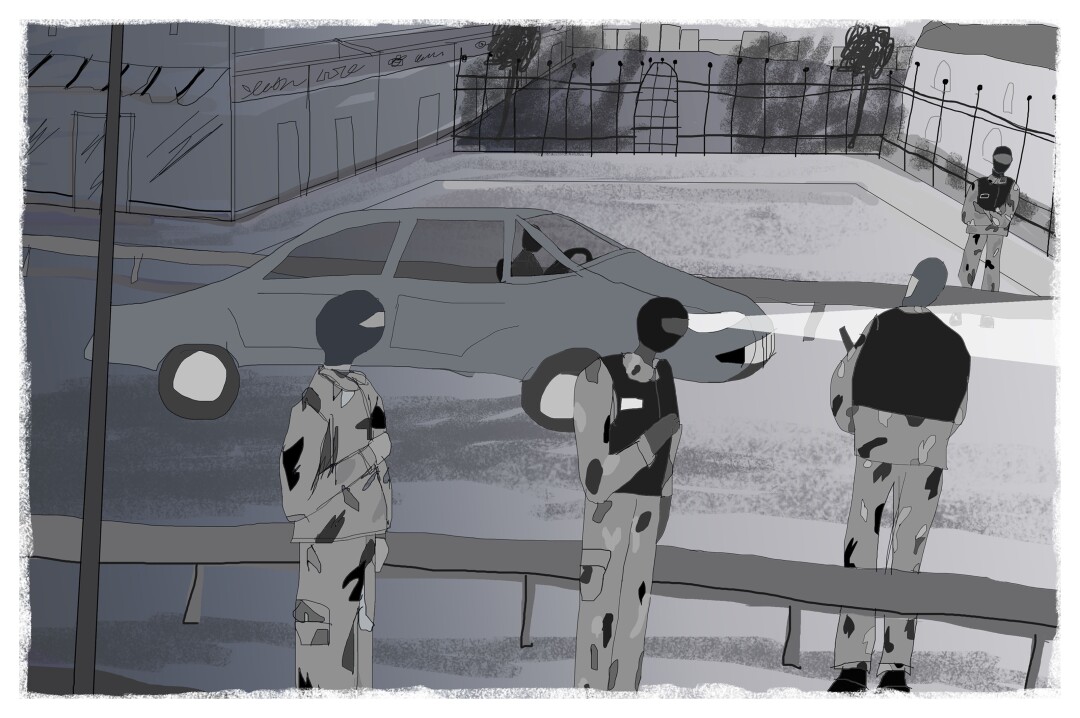
(Hannah Buckman / For The Times)
It’s hard to disagree with Schmidt and Magill as I drive into an eerily deserted Washington two days before the inauguration.
Stores are boarded up with plywood.
National Guard troops carrying rifles keep watch at checkpoints along a perimeter surrounding the U.S. Capitol, White House and National Mall. Usually busy streets inside the blockade are so quiet all I can hear is the cold wind blowing dead leaves down the carless pavement.
It feels like the end of the world. Will the inauguration, coming so soon after an insurrection, represent a new beginning for America?
In her inauguration poem, 22-year-old Amanda Gorman tells her splintered nation that “being American is more than a pride we inherit — it’s the past we step into and how we repair it.”
Vice President Kamala Harris, Second Gentleman Doug Emhoff, left, and family arrive at the White House after the inauguration.
(Kirk McKoy / Los Angeles Times)
I had stepped into our past and it left me feeling as if America was beyond repair, incapable of living up to visions like Gorman’s or Biden’s of a society that redeems itself by following through on its vows of justice, tolerance and equal opportunity.
Now Harris and her entourage make their way in front of me along a nearly empty Pennsylvania Avenue.
The late day sun bathes the White House in a golden hue, and Harris, all smiles and dressed in brilliant purple, turns to take in the view.
My heart pounds in my chest, tears pool in my eyes, and the skepticism about America that I’d carried across three states — and for much of my life — gives way to cautious optimism.
That image of Moore holding little Mariah at the start of my trip comes back to me as I watch Harris. Racism and white supremacy will persist, but Mariah’s America will be different from Moore’s and mine. She won’t have to spend her life wondering if her country is willing to elevate someone who looks like “that little girl,” as Harris famously referred to her childhood self, to the highest offices in the land.
I’m not fully healed. But for this precious moment, so brief I hardly have time to savor it, I’m not broken.
[ad_2]
Source link


